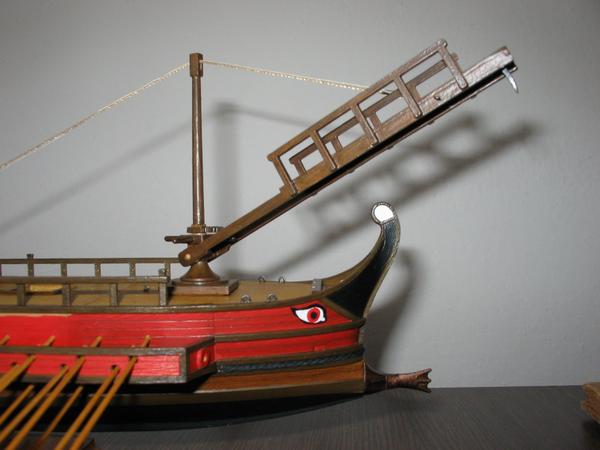Corvus
Corvus ("raven" or "crow"): a sort of crane, used to board an enemy ship.

During the First Punic War (264-241), the Romans for the first time faced a naval power, Carthage. Fighting at sea was difficult, but the Romans employed a secret weapon, the corvus, to change a naval battle into a land battle. This was a movable bridge with a metal prong that could be dropped onto the deck of a Carthaginian ship. Once the two ships were tied to each other, the Romans could use the ships as platforms for fighting. In 260, at Mylae, their consul Gaius Duillius were won their first naval victory.
The corvus is minutely described by the second-century Greek historian Polybius of Megalopolis. World History, 1.22-23 was translated by W.R. Paton and was taken from LacusCurtius.
The Romans approached to coast of Sicily and learning of the disaster that had befallen [another army], at once communicated with Gaius Duillius, the commander of the land forces, and awaited his arrival. At the same time, hearing that the enemy's fleet was not far distant, they began to get ready for sea-battle.
As their ships were ill-built and slow in their movements, someone suggested to them as a help in fighting the engines which afterwards came to be called "ravens". They were constructed as follows:
On the prow stood a round pole, seven meters in height and 30 centimeters in diameter. This pole had a pulley at the summit and round it was put a gangway made of cross planks attached by nails, 1.20 meters in width and eleven meters in length. In this gangway was an oblong hole and it went round the pole at a distance of 3½ meters from its near end. The gangway also had a railing on each of its long sides as high as a man's knee. At its extremity was fastened an iron object like a pestle pointed at one end and with a ring at the other end [...]. To this ring was attached a rope with which, when the ship charged an enemy, they raised the ravens by means of the pulley on the pole and let them down on the enemy's deck, sometimes from the prow and sometimes bringing them round when the ships collided broadsides.
Once the ravens were fixed in the planks of the enemy's deck and grappled the ships together, if they were broadside on, they boarded from all directions but if they charged with the prow, they attacked by passing over the gangway of the raven itself two abreast. The leading pair protected the front by holding up their shields, and those who followed secured the two flanks by resting the rims of their shields on the top of the railing.
Having, then, adopted this device, they awaited an opportunity for going into action.
As for Gaius Duillius, no sooner had he learnt of the disaster which had befallen the commander of the naval forces than handing over his legions to the military tribunes he proceeded to the fleet. Learning that the enemy were ravaging the territory of Mylae, he sailed against them with his whole force. The Carthaginians on sighting him put to sea with a 130 sail, quite overjoyed and eager, as they despised the inexperience of the Romans. They all sailed straight on the enemy, not even thinking it worth while to maintain order in the attack, but just as is they were falling on a prey that was obviously theirs. They were commanded by Hannibal [...].
On approaching and seeing the ravens nodding aloft on the prow of each ship, the Carthaginians were at first nonplused, being surprised at the construction of the engines. However, as they entirely gave the enemy up for lost, the front ships attacked daringly. But when the ships that came into collision were in every case held fast by the machines, and the Roman crews boarded by means of the ravens and attacked them hand to hand on deck, some of the Carthaginians were cut down and others surrendered from dismay at what was happening, the battle having become just like a fight on land.
So the first thirty that engaged were taken with all their crews, including the commander's galley, Hannibal himself managing to escape beyond his hopes by a miracle in the jolly-boat. The rest of the Carthaginian force was bearing up as if to charge the enemy, but seeing, as they approached, the fate of the advanced ships they turned aside and avoided the blows of the engines. Trusting in their swiftness, they veered round the enemy in the hope of being able to strike him in safety either on the broadside or on the stern, but when the ravens swung round and plunged down in all directions and in all manner of ways so that those who approached them were of necessity grappled, they finally gave way and took to flight, terror-stricken by this novel experience and with the loss of fifty ships.